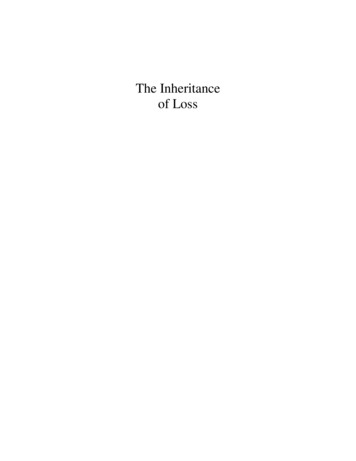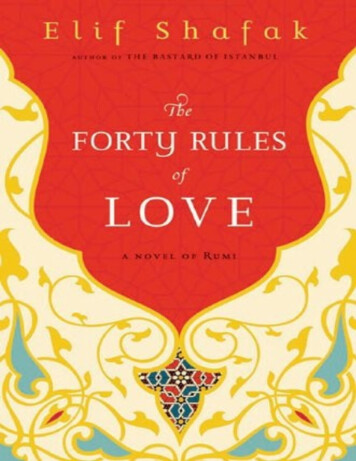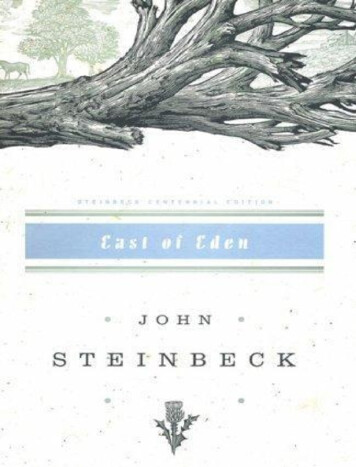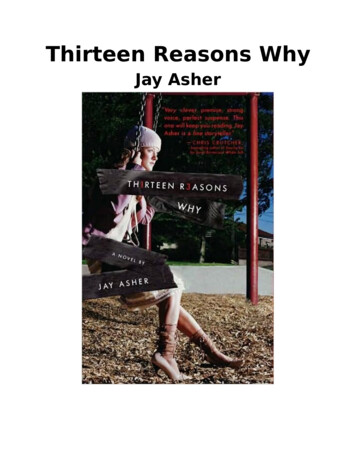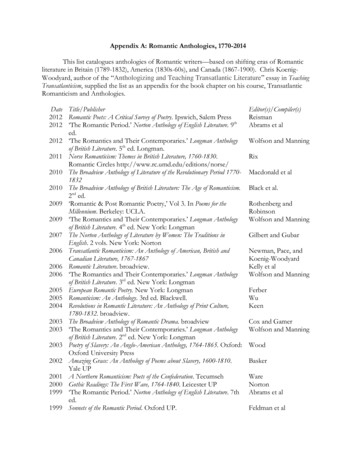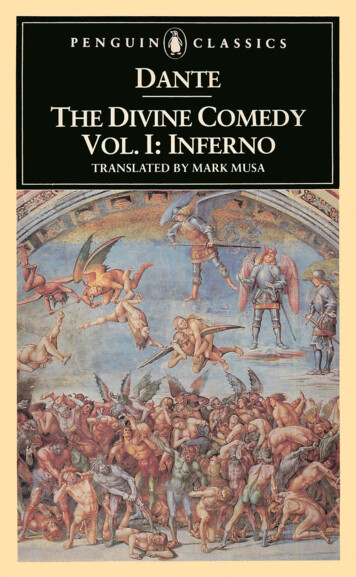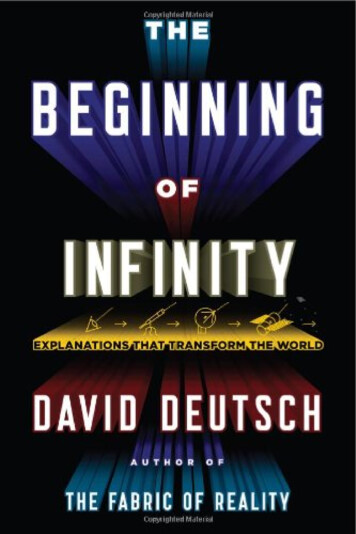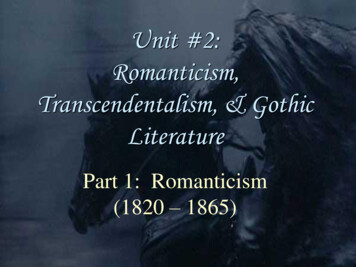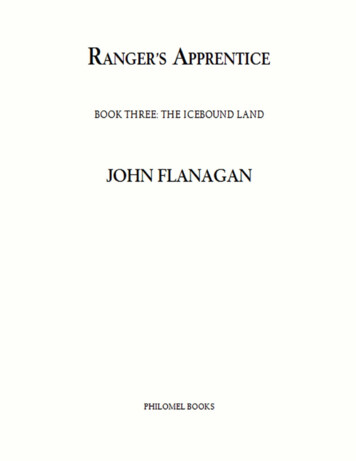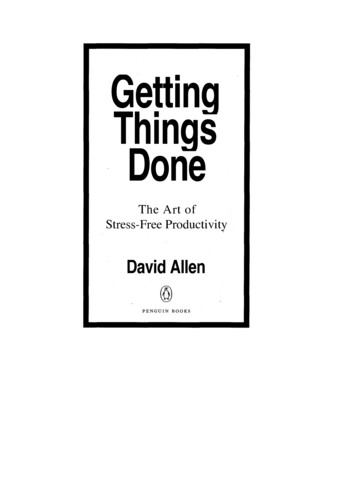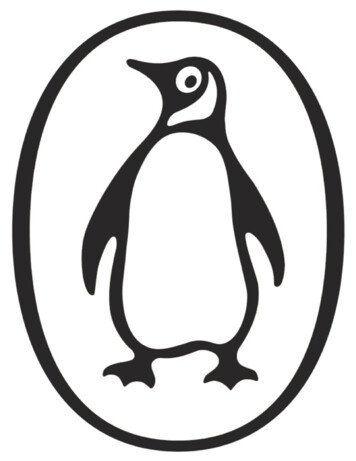
Transcription
THE PENGUIN BOOK OF ROMANTIC POETRYis descended from William Wordsworth’s younger brother,Christopher. He is Chairman of the Wordsworth Trust, Grasmere, retired Professor ofEnglish Literature at Oxford, and Fellow Emeritus of Exeter and St Catherine’s colleges.He has edited much of Wordsworth’s poetry, including the recent Penguin The Prelude:The Four Texts, and over 180 titles in the Woodstock Facsimile Series Revolution andRomanticism. He is the author of The Music of Humanity, The Borders of Vision, AncestralVoices, Visionary Gleam and The Bright Work Grows.JONATHAN WORDSWORTHgraduated from Mount Holyoke College, Massachusetts and took herMaster’s degree at Oxford. She is Administrator of the Wordsworth Winter School andSummer Conference at Grasmere, and is preparing the Penguin Selected Coleridge.JESSICA WORDSWORTH
The Penguin Book of Romantic PoetryEdited byJONATHAN and JESSICA WORDSWORTHPENGUIN BOOKS
PENGUIN BOOKSPublished by the Penguin GroupPenguin Books Ltd, 80 Strand, London WC2R 0RL, EnglandPenguin Group (USA) Inc., 375 Hudson Street, New York, New York 10014, USAPenguin Group (Canada), 10 Alcorn Avenue, Toronto, Ontario, Canada M4V 3B2(a division of Pearson Penguin Canada Inc.)Penguin Ireland, 25 St Stephen’s Green, Dublin 2, Ireland(a division of Penguin Books Ltd)Penguin Group (Australia), 250 Camberwell Road, Camberwell, Victoria 3124, Australia(a division of Pearson Australia Group Pty Ltd)Penguin Books India Pvt Ltd, 11 Community Centre, Panchsheel Park, New Delhi – 110017, IndiaPenguin Group (NZ), cnr Airborne and Rosedale Roads, Albany, Auckland 1310, NewZealand(a division of Pearson New Zealand Ltd)Penguin Books (South Africa) (Pty) Ltd, 24 Sturdee Avenue, Rosebank 2196, SouthAfricaPenguin Books Ltd, Registered Offices: 80 Strand, LondonWC2R 0RL,Englandwww.penguin.comThis collection first published in hardback as The New Penguin Book of Romantic Poetry2001Published in paperback by Penguin Books 2003Published under the current title in Penguin Classics 20054Copyright Jonathan and Jessica Wordsworth, 2001All rights reservedThe moral right of the author has been assertedExcept in the United States of America, this book is sold subjectto the condition that it shall not, by way of trade or otherwise, be lent,re-sold, hired out, or otherwise circulated without the publisher’sprior consent in any form of binding or cover other than that inwhich it is published and without a similar condition including thiscondition being imposed on the subsequent purchaserEISBN: 9781101489406
For the twins, Helen Emily and Giles Philipa child more than all other gifts Brings hope with it and forward looking thoughts
CONTENTSPREFACEINTRODUCTION: THE ROMANTIC PERIOD1. Origins(i) Revolution and Romantic Vision(ii) A New Style and a New Spirit(iii) ‘And All Things In Himself’: Romantic Platonism2. The Romantic Poets In Context(i) The First Generation(ii) A Gap(iii) The Second Generation(iv) The Sense of an EndingTHE POETRYI. Romantic Hallmarks1.CHARLOTTE SMITH:To the South Downs (Elegiac Sonnets 1784)2.ROBERT BURNS:3.MARY ROBINSON:4.SAMUEL TAYLOR COLERIDGE:5.CHARLES LAMB:6.WILLIAM WORDSWORTH:To a Mountain Daisy (1786)A London Summer Morning (1794; publ. 1804)Kubla Khan (Nov. 1797; publ. 1816)Old Familiar Faces (1798)Lucy Poems (winter 1798–9; publ. Lyrical Ballads 1800)(i) Lucy Gray (c. Nov.)(ii) Strange Fits of Passion I Have Known (c. Dec.)(iii) She Dwelt Among the Untrodden Ways (c. Dec.)(iv) A Slumber Did My Spirit Seal (c. Dec.)
(v) Three Years She Grew (Feb.)7.THOMAS CAMPBELL:Hohenlinden (1801; publ. 1809)8.ROBERT SOUTHEY:9.WILLIAM BLAKE:And Did Those Feet (1802–4; engraved Milton c. 1808)10.WALTER SCOTT:Lochinvar (Marmion 1808)11.THOMAS MOORE:12.LORD BYRON:13.JOHN KEATS:14.PERCY BYSSHE SHELLEY:15.JAMES HOGG:When the Kye Comes Hame (1823)16.JOHN CLARE:The Shepherd’s Calendar (July, 90–131) c. 1824; publ. 182717.THOMAS HOOD:18.FELICIA HEMANS:19.LETITIA ELIZABETH LANDON:20.CAROLINE NORTON:My Arab Steed (1830)21.JAMES LEIGH HUNT:Abou Ben Adhem (1834)The Inchcape Rock (1803)Oh! Blame Not the Bard (1810)‘Revelry by Night’ (Childe Harold III, stanzas 16–18, 21–8) April1816; publ. Dec.To Autumn (Sept. 1819; publ. 1820)To a Skylark (1820)I Remember, I Remember (1826)Casabianca (1824; publ. 1826)Lines of Life (1829)II. Narratives of Love1.MARY ROBINSON:from Sappho and Phaon (1796)2.WILLIAM WORDSWORTH:3.SAMUEL TAYLOR COLERIDGE:4.WILLIAM BLAKE:The Ruined Cottage (1797–8; Excursion 1814 from MS 1968)Love (Nov. 1799; publ. 1817)(i) The Crystal Cabinet (c. 1803; from MS 1905)(ii) The Mental Traveller (c. 1803; from MS 1905)
5.MARY TIGHE:‘A Glimpse of Love’ (Psyche I, stanzas 16–32) 1802–3; publ. 18056.THOMAS CAMPBELL:7.LORD BYRON:8.PERCY BYSSHE SHELLEY:9.JAMES LEIGH HUNT:Gertrude of Wyoming II (1809)The Bride of Abydos (stanzas 22–7) 1814Alastor (lines 140–222) 1816Paulo and Francesca (Rimini III, lines 482–564) 181610.THOMAS MOORE:The Fire-Worshippers (from Lalla Rookh III, lines 201–453) 181711.JOHN KEATS:The Eve of St Agnes (Jan.–Feb. 1819; publ. 1820)12.LORD BYRON:Juan and Haidee (from Don Juan II–IV) 1819–2113.LETITIA ELIZABETH LANDON:14.FELICIA HEMANS:15.CAROLINE NORTON:The Indian Bride (Improvisatrice 1823)Arabella Stuart (Records of Woman 1828)The Faithless Knight (1830)III. Romantic Solitude, Suffering and Endurance1.WILLIAM COWPER:Crazy Kate (Task I, 534–56) 17852.JOANNA BAILLIE:3.CHARLOTTE SMITH:4.WILLIAM BLAKE:5.ROBERT SOUTHEY:6.WILLIAM WORDSWORTH:The Storm-Beat Maid (1790)The Female Exile (Nov. 1792; publ. 1797)Visions of the Daughters of Albion (1793)Mary the Maid of the Inn (1797)Wordsworthian Solitaries(i) Old Man Travelling (May 1797; Lyrical Ballads 1798)(ii) The Discharged Soldier (Feb. 1798; publ. 1850/from MS 1970)(iii) The Mad Mother (Lyrical Ballads 1798)(iv) Complaint of a Forsaken Indian Woman (Lyrical Ballads 1798)(v) Michael (lines 217–490) Lyrical Ballads 1800(vi) The Leech-Gatherer (spring 1802; publ. 1807)
(vii) The London Beggar (1805 Prelude VII, 594–622) publ. 1850/from MS19267.SAMUEL TAYLOR COLERIDGE:‘Alone, Alone’(i) The Ancient Mariner (Lyrical Ballads 1798)(ii) Pains of Sleep (Sept. 1803; publ. 1816)8.THOMAS CAMPBELL:Lord Ullin’s Daughter (1809)9.MARY BRYAN:The Visit (lines 45–126) 181510.LORD BYRON:The Prisoner of Chillon (1816)11.JOHN KEATS:Isabella, or The Pot of Basil (stanzas 32–63) April 1818; publ. 182012.PERCY BYSSHE SHELLEY:13.LORD BYRON:14.THOMAS HOOD:15.FELICIA HEMANS:16.LETITIA ELIZABETH LANDON:Final Moments (The Cenci V, scenes iii–iv) 1819The Shipwreck (from Don Juan II) 1819The Dream of Eugene Aram (1826)Indian Woman’s Death Song (Records of Woman 1828)She Sat Alone Beside Her Hearth (c. 1835; publ. 1839)IV. Ennobling Interchange: Man and Nature1.ANNA LAETITIA BARBAULD:(i) The Mouse’s Petition (1773)(ii) from A Summer’s Evening’s Meditation (lines 17–98) 17732.WILLIAM COWPER:The Winter Evening (Task IV, 267–332) 17853.ROBERT BURNS:4.SAMUEL TAYLOR COLERIDGE:To a Mouse, On Turning Her Up in Her Nest with the Plough,November 1785 (1786)Conversation Poems(i) The Eolian Harp (20 Aug. 1795; publ. 1796)(ii) This Lime-Tree Bower, My Prison (July 1797; publ. 1800)(iii) Frost at Midnight (Feb. 1798; publ. 1798)(iv) The Nightingale (May 1798; publ. Lyrical Ballads)
5.WILLIAM WORDSWORTH:‘Images of a Mighty Mind’(i) Tintern Abbey (13 July 1798; publ. Lyrical Ballads)(ii) There Was a Boy (Oct. 1798; publ. Lyrical Ballads 1800)(iii) The Two-Part Prelude (Oct. 1798–Dec. 1799; publ. 1850/from MS 1972)(iv) Statue Horse (Feb. 1804; from MS 1969)(v) Climbing of Snowdon (1805 Prelude XIII, 10–73) Feb. 1804; publ.1850/from MS 1926(vi) Crossing the Alps (1805 Prelude VI, 494–572) March 1804; publ.1850/from MS 19266.WILLIAM LISLE BOWLES:7.CHARLOTTE SMITH:8.AMELIA OPIE:9.ISABELLA LICKBARROW:10.LORD BYRON:from Coombe Ellen (1798)Beachy Head (lines 346–505) c. 1805; publ. 1807Stanzas Written Under Aeolus’ Harp (1808)On Esthwaite Water (1814)‘Concentred in a Life Intense’(i) Lake Leman (from Childe Harold III) June 1816; publ. Dec. 1817(ii) Epistle to Augusta (July 1816; publ. 1830)11.PERCY BYSSHE SHELLEY:‘The Secret Strength of Things’(i) Mont Blanc (July 1816; publ. 1817)(ii) To Jane: The Invitation (2 Feb. 1822; publ. 1824)(iii) To Jane: A Recollection (Feb. 1822; publ. 1824)12.JOHN KEATS:‘A Sort of Oneness’(i) Endymion (I, 777–802) c. April 1817; publ. 1818(ii) Epistle to J. H. Reynolds (lines 82–105) March 1818; publ. 184813.SAMUEL PALMER:Twilight Time (lines 1–24) c. 1827; from MS 194214.JOHN CLARE:15.FELICIA HEMANS:16.LETITIA ELIZABETH LANDON:This Leaning Tree with Ivy Overhung (early 1830s; from MS 1979)Remembrance of Nature (1835; publ. 1838)
(i) Scale Force, Cumberland (c. 1836; publ. 1839)(ii) Fountains Abbey (c. 1836; publ. 1839)V. Romantic Odes1.ROBERT BURNS:Despondency, An Ode (1786)2.WILLIAM WORDSWORTH:3.SAMUEL TAYLOR COLERIDGE:4.PERCY BYSSHE SHELLEY:5.JOHN KEATS:The Immortality Ode (spring 1802/Feb. 1804; publ. 1807)Dejection: An Ode (summer 1802; publ. 4 Oct.)Hymn to Intellectual Beauty (July 1816; publ. Jan. 1817)Odes of Spring 1819 (publ. 1820)(i) Ode to Psyche (late April)(ii) Ode to a Nightingale (early May)(iii) Ode on a Grecian Urn (May)(iv) Ode on Melancholy (May)(v) Ode on Indolence (late May)6.PERCY BYSSHE SHELLEY:Ode to the West Wind (Oct. 1819; publ. 1820)VI. Romantic Lyric and Song1.WILLIAM BLAKE:Song (‘How sweet I roamed’) Poetical Sketches 17832.ROBERT BURNS:Songs 1786–93(i) It Was upon a Lammas Night (1786)(ii) The Banks o’ Doon (March 1791; publ. 1808)(iii) A Red Red Rose (collected 1793; publ. 1794)3.WILLIAM BLAKE:from Songs of Innocence (1784–9; engraved 1789)(i) Introduction(ii) The Shepherd(iii) Infant Joy(iv) The Echoing Green(v) Laughing Song (May 1784)
(vi) Nurse’s Song (c. 1784)(vii) Holy Thursday (c. 1784)(viii) The Lamb(ix) The Chimney Sweeper(x) The Divine Image4.SUSANNA BLAMIRE:(i) The Siller Croun (1790; publ. 1842)(ii) Oh Bid Me Not to Wander (c. 1792; publ. 1842)5.WILLIAM BLAKE:from Songs of Experience (1791–2; engraved 1794)(i) Introduction (c. 1794)(ii) Earth’s Answer (c. 1794)(iii) My Pretty Rose Tree(iv) The Clod and the Pebble(v) The Garden of Love(vi) A Poison Tree(vii) Infant Sorrow(viii) London(ix) Nurse’s Song(x) The Tyger(xi) The Human Abstract(xii) The Sick Rose(xiii) The Chimney Sweeper(xiv) Holy Thursday(xv) The Fly(xvi) Ah! Sun-Flower (written c. 1794)6.ANN BATTEN CRISTALL:7.MARY ROBINSON:Through Springtime Walks (1795)A Thousand Torments (1797)
8.THOMAS CAMPBELL:Written on Visiting a Scene in Argyleshire (c. 1798; publ. 1800)9.WILLIAM WORDSWORTH:I. Alfoxden Lyric (1798; publ. Lyrical Ballads)Lines Written in Early SpringII. Goslar Lyrics (1798–9; publ. Lyrical Ballads 1800)(i) Two April Mornings(ii) The FountainIII. Grasmere Lyrics (spring 1802; publ. Poems 1807)(i) To the Cuckoo(ii) The Rainbow(iii) To H. C., Six Years Old(iv) The Cock is Crowing(v) To a Butterfly (‘I’ve watched you’)(vi) I Have Thoughts that Are Fed by the Sun (from MS 1947)(vii) The Sun Has Long Been SetIV. Grasmere Lyrics (1804–5; publ. Poems 1807)(i) Daffodils (Feb. 1804, expanded c. 1815)(ii) Stepping Westward(iii) The Solitary Reaper10.SAMUEL TAYLOR COLERIDGE:Lyrics 1798–1803(i) Something Childish, but Very Natural (April 1799; publ. 1800)(ii) The Keepsake (1802)(iii) Answer to a Child’s Question (1802)11.THOMAS MOORE:Away with this Pouting (1801)12.CHARLOTTE SMITH:A Walk by the Water (1804)
13.MARY TIGHE:Address to My Harp (c. 1804; publ. 1811)14.DOROTHY WORDSWORTH:15.JANE TAYLOR:16.LORD BYRON:A Cottage in Grasmere Vale (c. 1805; from MS 1882)The Star (1806)Lyrics Early and Late(i) The Maid of Athens (c. Jan. 1810; publ. 1812)(ii) She Walks in Beauty (June 1814; publ. 1815)(iii) Stanzas for Music (‘There be none of Beauty’s daughters’) 1816(iv) Stanzas for Music (‘There’s not a joy’) 1816(v) We’ll Go No More A-Roving (28 Feb. 1817; publ. 1830)(vi) The Isles of Greece (Don Juan, Canto III, 86–7) 1821(vii) On This Day I Complete My Thirty-Sixth Year (22 Jan. 1824; publ. 1824)17.PERCY BYSSHE SHELLEY:Lyric Poetry 1817–21(i) To Constantia, Singing (late 1817; publ. Jan. 1818)(ii) Stanzas Written in Dejection, December 1818, Near Naples (publ. 1824)(iii) The Cloud (1820)(iv) Hellas: The Last Chorus (Oct. 1821; publ. 1822)(v) Music, When Soft Voices Die (c. 1821; publ. 1824)18.JOHN KEATS:Lyrics 1818–19(i) Where Be Ye Going (21 March 1818; publ. 1848)(ii) The Witching Time (14 Oct. 1818; publ. 1848)(iii) I Had a Dove (c. Dec. 1818; publ. 1848)(iv) Hush, Hush! Tread Softly (c. Dec. 1818; publ. 1845)(v) This Living Hand (c. Nov. 1819; from MS 1898)19.JOHN CLARE:Song (‘Sad was the day’) 182020.THOMAS HOOD:21.CHARLES LAMB:Ruth (1827)
(i) To Louisa Martin, Whom I Used to Call ‘Monkey’ (1827)(ii) In My Own Album (1829)22.LETITIA ELIZABETH LANDON:23.FELICIA HEMANS:Song: ‘My heart is like the failing hearth’ (1827)(i) The Graves of a Household (1828)(ii) A Parting Song (1828)24.CAROLINE NORTON:25.JAMES HOGG:Dreams (1830)When Maggy Gangs Away (1831)VII. The Romantic Sonnet1.THOMAS WARTON:To the River Loden (1777)2.CHARLOTTE SMITH:from Elegiac Sonnets, 1784(i) The Partial Muse(ii) Should the Lone Wanderer3.WILLIAM LISLE BOWLES:from Fourteen Sonnets, 1789(i) At a Village in Scotland(ii) To the River Itchin4.SAMUEL TAYLOR COLERIDGE:(i) Pantisocracy (1794)(ii) To the River Otter (1796)5.MARY ROBINSON:from Sappho and Phaon (1796)(i) Sappho’s Conjectures(ii) Her Address to the Moon(iii) To Phaon6.CHARLES LAMB:When Last I Roved (1797)7.ROBERT SOUTHEY:8.CHARLES LLOYD:To a Brook Near the Village of Corston (1797)On the Death of Priscilla Farmer (1797)
9.ANNA SEWARD:By Derwent’s Rapid Stream (1799)10.MARY TIGHE:Written at Scarborough (1799)11.CHARLOTTE SMITH:from Elegiac Sonnets, 1799(i) Written at the Close of Spring(ii) From the Thirteenth Cantata of Metastasio(iii) To the Earl of Egremont12.WILLIAM WORDSWORTH:Sonnets of 1802 (publ. 1807)(i) I Grieved for Bonaparté (21 May)(ii) With Ships the Sea Was Sprinkled(iii) Westminster Bridge (3 Sept.)(iv) Milton, Thou Shouldst Be Living at this Hour(v) The World Is Too Much with Us(vi) Ere We Had Reached the Wished-for Place (4 Oct.)(vii) Nuns Fret Not(viii) Scorn Not the Sonnet (c. 1802; publ. 1827)13.MARY TIGHE:To Death (c. 1805; publ. 1811)14.JAMES LEIGH HUNT:Sonnets, 1814–18(i) Written During the Author’s Imprisonment, November 1814 (Examiner)(ii) Written in the Spring that Succeeded Imprisonment, May 1815 (Examiner)(iii) On a Lock of Milton’s Hair (Jan. 1818, Examiner)15.MARY BRYAN:To My Brother (1815)16.LORD BYRON:Sonnets Written at the Villa Diodati, July 1816(i) Sonnet on Chillon (1816)(ii) Sonnet to Lake Leman (1816)17.JOHN KEATS:Sonnets of 1816–19(i) On First Looking into Chapman’s Homer (Oct. 1816; publ. Dec.)
(ii) Great Spirits Now on Earth are Sojourning (19–20 Nov. 1816; publ. 1817)(iii) To Mrs Reynolds’ Cat (16 Jan. 1818; publ. 1830)(iv) On Sitting Down to Read ‘King Lear’ Once Again (22 Jan. 1818; publ. 1838)(v) When I Have Fears that I May Cease to Be (late Jan. 1818; publ. 1848)(vi) Bright Star (autumn 1819; publ. 1838)18.HORACE SMITH:In Egypt’s Sandy Silence (Dec. 1817; publ. 1 Feb. 1818)19.PERCY BYSSHE SHELLEY:(i) Ozymandias (Dec. 1817; publ. 11 Jan. 1818)(ii) Lift Not the Painted Veil (late 1819; publ. 1824)20.JOHN CLARE:(i) Give Me the Gloomy Walk (1819–20; publ. 1820)(ii) A Wish (1819–20; publ. 1828)21.WILLIAM WORDSWORTH:The River Duddon: Afterthought (1820)22.SAMUEL TAYLOR COLERIDGE:23.THOMAS HOOD:24.HARTLEY COLERIDGE:25.FELICIA HEMANS:26.CAROLINE NORTON:27.LETITIA ELIZABETH LANDON:To Nature (1820)Written in Keats’ ‘Endymion’ (London Magazine 1823)Long Time a Child (1833)To a Distant Scene (1834)Be Frank with Me (1830)The Castle of Chillon (1835)VIII. The Gothic and Surreal1.WILLIAM BLAKE:Fair Elenor (Poetical Sketches 1783)2.HELEN MARIA WILLIAMS:3.ROBERT BURNS:4.GOTTFRIED BÜRGERTower (1786)Part of an Irregular Fragment Found in a Dark Passage of theTam O’ Shanter (late 1790; publ. 1791)(trans.WILLIAM TAYLOR,1796):
(i) Lenora(ii) The Lass of Fair Wone5.MATTHEW ‘MONK’ LEWIS:Alonzo the Brave and the Fair Imogine (1796)6.WILLIAM WORDSWORTH:The Thorn (March 1798; publ. Lyrical Ballads)7.SAMUEL TAYLOR COLERIDGE:8.ROBERT SOUTHEY:9.MARY ROBINSON:Christabel, Part I (April 1798; publ. 1816)The Old Woman of Berkeley (1799)The Haunted Beach (1800)10.WALTER SCOTT:The Lay of the Last Minstrel (Canto II, stanzas 1–23) 180511.JAMES HOGG:12.GEORGE CRABBE:13.LORD BYRON:Darkness (1816)14.JOHN KEATS:La Belle Dame Sans Merci (21 April 1819; Indicator, May 1820)15.JOHN CLARE:Superstition’s Dream (lines 13–68) 182216.THOMAS LOVELL BEDDOES:17.THOMAS CAMPBELL:18.THOMAS HOOD:The Wife of Crowle (1807)Peter Grimes (1810)The Bride’s Tragedy II, scene iv, lines 1–64 (1822)The Last Man (1823)The Last Man (1826; publ. 1829)IX. Romantic Comedy and Satire1.WILLIAM BLAKE:Songs from An Island in the Moon (c. 1784; from MS 1907)(i) Old Corruption(ii) Lo, the Bat(iii) Village Cricket2.ROBERT BURNS:Holy Willie’s Prayer (1786)3.MARY ROBINSON:4.WILLIAM WORDSWORTH:January, 1795 (publ. 1796)Ballad Comedies, Spring 1798:
(i) The Idiot Boy (late March; publ. Lyrical Ballads)(ii) from Peter Bell (late April; publ. 1819)(iii) We Are Seven (late April/early May; publ. Lyrical Ballads)5.JOHN HOOKHAM FRERE AND GEORGE CANNING:from The Rovers (June 1798)6.ROBERT SOUTHEY AND SAMUEL TAYLOR COLERIDGE:7.GEORGE CRABBE:8.JAMES SMITH:The Baby’s Debut, by W. W. (Rejected Addresses 1812)9.JAMES HOGG:from The Poetic Mirror (1816)The Devil’s Thoughts (1799)Procrastination (1812)(i) James Rigg (lines 1–42)(ii) Isabelle10.JOHN HOOKHAM FRERE:11.JOHN KEATS:12.PERCY BYSSHE SHELLEY:13.LORD BYRON:14.ROBERT SOUTHEY:15.THOMAS LOVE PEACOCK:16.THOMAS HOOD:17.CAROLINE NORTON:1–7, 15–19) 1818‘Irrational Gigantic Anger’ (Whistlecraft, Canto III, stanzasOld Meg She Was a Gypsy (2 July 1818; publ. 1838)Sin (Peter Bell the Third IV, 1–65) 1819; publ. 1839Juan and Julia (Don Juan I, stanzas 54–117, 133–87) 1819The Cataract of Lodore (1823)The Legend of Manor Hall (c. 1824; publ. 1837)Mary’s Ghost (1826)First Love (1830)X. Protest and Politics1.WILLIAM COWPER:2.HANNAH MORE:from Slavery: A Poem (1788)3.ANN YEARSLEY:Death of Luco (from On the Inhumanity of the Slave Trade) 17884.ANNA LAETITIA BARBAULD:(publ. 1825)Sweet Meat Has Sour Sauce (1788)On the Expected General Rising of the French Nation in 1792
5.HELEN MARIA WILLIAMS:France 1792 (from To Dr Moore) 17926.WILLIAM WORDSWORTH:7.ROBERT BURNS:8.ROBERT SOUTHEY:9.SAMUEL TAYLOR COLERIDGE:The Female Vagrant, stanzas 33–6, 40–43 (1793–4; publ.Lyrical Ballads 1798)For A’ That and A’ That (1795)Poems on the Slave Trade (April 1798; publ. 1799)(i) France: An Ode (1798)(ii) ‘Dainty Terms for Fratricide’ (Fears in Solitude, 90–93, 101–20) 179810.ROBERT SOUTHEY:The Battle of Blenheim (1799)11.ROBERT BLOOMFIELD:12.WILLIAM WORDSWORTH:The Farmer’s Boy (from Summer) 1801I. Sonnets 1802 (publ. 1807)(i) On the Extinction of the Venetian Republic(ii) To Toussaint L’Ouverture(iii) We Had a Fellow-PassengerII. Prelude Scenes from the French Revolution (1804; publ. 1850/from MS1926)(i) ‘Golden Hours’: Calais and the Rhone, July 1790 (VI, 352–69, 380–413)(ii) A Tourist’s Unconcern: Paris, Dec. 1791 (IX, 40–71)(iii) Among Royalists: Blois, spring 1792 (IX, 127–68)(iv) ‘A Patriot’: Blois, early summer 1792 (IX, 294–9, 511–34)(v) ‘Sleep No More’: Paris, Oct. 1792 (X, 24–82)(vi) War and Alienation: London and Wales, 1793–4 (X, 201–74)(vii) ‘Eternal Justice’: Morecambe Sands, Aug. 1794 (X, 466–76, 515–56)13.JOHN CLARE:
(i) Helpstone (lines 95–134) c. 1813; publ. 1820(ii) Lamentations of Round-Oak Waters (lines 157–96) 1818; publ. 182114.JAMES LEIGH HUNT:from The St James’s Phenomenon (1814)15.LORD BYRON:16.PERCY BYSSHE SHELLEY:Napoleon’s Farewell (1814; publ. 1816)(i) The Mask of Anarchy (Sept. 1819; publ. 1832)(ii) England in 1819 (23 Dec.; publ. 1839)17.LORD BYRON:from The Vision of Judgment (1822)18.THOMAS HOOD:19.LETITIA ELIZABETH LANDON:20.CAROLINE NORTON:Ode to H. Bodkin, Esq., Secretary to the Society for the Suppression ofMendicity (1824)The Factory (1835)A Voice from the Factories (stanzas 34–48) 1836XI. Poets in Relationship1.WILLIAM BLAKE:2.ROBERT BURNS:1783)and Catherine Blake, I Love the Jocund Dance (Poetical Sketches(I) and Elizabeth Paton, A Poet’s Welcome to his Love-begotten Daughter (May1785; publ. 1801)(II) and Agnes Craif McLehose, Ae Fond Kiss (Dec. 1787; publ. 1792)(III) and Jean Armour (by now Mrs Burns), I Love My Jean (April 1788; publ.1790)(IV) and Mary Campbell, Highland Mary (Nov. 1792; publ. 1799)3.CHARLOTTE SMITH:4.MARY ROBINSON:5.WILLIAM COWPER:6.CHARLES LAMB:To My Children (1788)and General Sir Banastre Tarleton, Written Between Dover andCalais, July 1792 (1793)and Mary Unwin, To Mary (autumn 1793; publ. 1803)To Mary Ann Lamb (1795; publ. 1797)
7.SAMUEL TAYLOR COLERIDGE:(i) Composed on a Journey Homeward, the Author Having Received Intelligence ofthe Birth of a Son, September 20, 1796 (1797)(ii) Letter to Sara Hutchinson: 4 April 1802, Sunday Evening (from MS 1936)8.WILLIAM WORDSWORTH:(I) and Dorothy Wordsworth(i) To My Sister (March 1798; publ. Lyrical Ballads 1798)(ii) from Home at Grasmere (March 1800; publ. from MS 1888)(iii) To a Butterfly (‘Stay near me’) spring 1802; publ. 1807(iv) The Sparrow’s Nest (spring 1802; publ. 1807)(v) ‘Child of My Parents’ (1805 Prelude XIII 210–46) publ. 1850/from MS1926(II) and Caroline (Vallon) Wordsworth, It is a Beauteous Evening (Aug. 1802;publ. 1807)(III) and Mary Wordsworth (née Hutchinson)(i) She Was a Phantom of Delight (Feb. 1804; publ. 1807)(ii) ‘Another Maid There Was’ (1805 Prelude VI 233–9, XI 215–22) publ.1850/from MS 1926(IV) and Catharine Wordsworth, Surprised by Joy (c. 1813–14; publ. 1815)9.PERCY BYSSHE SHELLEY:(I) and Harriet Shelley (née Westbrook), To Harriet (1812)(II) and Mary Shelley (née Godwin), from Dedication to Laon and Cythna 1–46,91–126 (1817)(III) and Teresa Viviani, Epipsychidion (1821)(IV) and Jane Williams(i) To Jane with a Guitar (June 1822; publ. 1832)(ii) To Jane: The Stars Were Twinkling (June 1822; publ. 1832)10.LORD BYRON:
(I) and Lady Frances Webster, When We Two Parted (Aug.–Sept. 1815; publ.1816)(II) and Lady Byron, Fare Thee Well (1816)(III) and Augusta Leigh(i) Stanzas to Augusta (‘When all around’) 1816(ii) Stanzas to Augusta (‘Though the day of my destiny’) 1816(IV) and the Countess Guiccioli, Stanzas to the River Po (April 1819; publ. 1824)(V) and Loukas Chalandritsanos, I Watched Thee (April 1824; from MS 1887)11.JOHN KEATS:and Fanny Brawne(i) The Day Is Gone (10 Oct. 1819; publ. 1838)(ii) I Cry Your Mercy (mid Oct. 1819; publ. 1848)(iii) Ode to Fanny (Feb. 1820; publ. 1848)12.JOHN CLARE:and Mary Joyce(i) Song (‘Mary leave thy lowly cot’) 1819–20; publ. 1821(ii) My Mary (1820)(iii) Ballad (‘Mary, fate lent me a moment’) 1819–20; publ. 182113.FELICIA HEMANS:The Dreaming Child (1830)14.CAROLINE NORTON:(I) and her brother, Recollections (1830)(II) and her children, The Mother’s Heart (1836)15.LETITIA ELIZABETH LANDON:To My Brother (1835)XII. On Poets and Poetry1.MARY SCOTT:2.ROBERT BURNS:(1774)on Anna Laetitia Barbauld (née Aikin), from The Female Advocate(i) Epistle to J. Lapraik, An Old Scotch Bard (April 1785; publ. 1786)(ii) I Am a Bard (c. autumn 1785; publ. 1799)
3.HELEN MARIA WILLIAMS:4.JOANNA BAILLIE:5.WILLIAM BLAKE:publ. 1791)Sonnet on Reading ‘The Mountain Daisy’ by Burns (c. 1787;An Address to the Muses (lines 49–102) 1790(i) Preface to Europe, A Prophecy (engraved 1794)(ii) ‘I Come In Self-Annihilation’ (Milton plate 41, 2–28) c. 1804, engraved c.1808–10(iii) ‘Trembling I Sit’ (Jerusalem, plate 5, 16–20) c. 1804–7; engraved c. 18186.SAMUEL TAYLOR COLERIDGE:Nehemiah Higginbottom Sonnets (Nov. 1797)(i) ‘Pensive at Eve’(ii) ‘Oh I Do Love Thee’(iii) ‘And This Reft House’7.WILLIAM WORDSWORTH:Thoughts on Poetic Imagination, 1798–1806(i) from the Prologue to Peter Bell (April 1798; publ. 1819)(ii) The Glad Preamble (c. 18 Nov. 1799; publ. Prelude 1850/from MS 1926)(iii) ‘A Dedicated Spirit’ (1805 Prelude IV 316–45; publ. 1850/from MS 1926)(iv) Elegiac Stanzas, Suggested by a Picture of Peele Castle in a Storm (May–June1806; publ. 1807)8.ANNA LAETITIA BARBAULD:9.MARY ROBINSON:To Mr Coleridge (1799)(i) Ode Inscribed to the Infant Son of S. T. Coleridge, Esq., Born 14 Sept 1800 (lines67–102) Sept 1800; publ. 1806(ii) To the Poet Coleridge (Oct. 1800; publ. 1806)10.WILLIAM WORDSWORTH:Portraits of Coleridge(i) from The Castle of Indolence Stanzas (May 1802; publ. 1807)(ii) ‘A Mind Debarred’ (1805 Prelude VI, 239–329) 1804; publ. 1850/from MS1926(iii) A Complaint (c. Dec. 1806; publ. 1807)
11.MARY TIGHE:‘Dreams of Delight, Farewell’ (Psyche, concluding stanzas) 1802–3;publ. 180512.SAMUEL TAYLOR COLERIDGE:13.LORD BYRON:14.JAMES LEIGH HUNT:15.LORD BYRON:16.PERCY BYSSHE SHELLEY:17.JOHN KEATS:1817To William Wordsworth (Jan. 1807; publ. 1817)English Bards and Scotch Reviewers (lines 1–38, 85–148) 1809Feast of the Poets (lines 204–41) 1811; expanded 1814‘’Tis to Create’ (Childe Harold III, stanzas 3–6) April 1816; publ.To Wordsworth (1816)(i) Sleep and Poetry (lines 96–162) 1817(ii) The Fall of Hyperion: A Dream (Canto I, lines 1–27, 87–294) July–Sept. 1819;185618.PERCY BYSSHE SHELLEY:(i) Julian and Maddalo: A Conversation (lines 1–67) Oct. 1818; publ. 1824(ii) Adonais: An Elegy on the Death of John Keats (stanzas 1–8, 39–58) 182219.LETITIA ELIZABETH LANDON:Sappho’s Song (1824)20.SAMUEL TAYLOR COLERIDGE:Work Without Hope (21 Feb. 1825; publ. 1828)21.THOMAS HOOD:22.FELICIA HEMANS:False Poets and True (1827)(i) The Grave of a Poetess (Records of Woman 1828)(ii) Properzia Rossi (Records of Woman 1828)(iii) To Wordsworth (1828)23.WILLIAM WORDSWORTH:Extempore Effusion Upon the Death of James Hogg (1835)24.LETITIA ELIZABETH LANDON:(i) Felicia Hemans (c. 1835; publ. 1838)(ii) The Poet’s Lot (c. 1837; publ. 1841)
NOTESSHORT BIOGRAPHIESINDEX OF POETS AND THEIR WORKSINDEX OF TITLESINDEX OF FIRST LINES
PREFACERomanticism is the mood in which ‘we recognize / A grandeur in the beatings of theheart’, in which ‘We feel that we are greater than we know’ (Wordsworth). It is avaluing of emotion, of imagination, a belief in human potential taken beyond itsordinary limits. It belongs to no period. Philip Sidney invoked it when he saw in hisElizabethan contemporaries ‘a want of inward touch’. Wallace Stevens evokes it in the1940s asthe yes of the realist spoken because he mustSay yes, spoken because under every no[Lies] a craving for yes that [has] never been broken.There is every reason to think of Plato in certain moods as a Romantic. In Hazlitt’swords, it is a way of thinking ‘as old as the heart of man’.Yet there are times when Romantic thinking, feeling, understanding are more likely.Something happens in the years following the French Revolution that is unique. Not thatall writers suddenly became Romantic. The vast majority didn’t – either because theirvalues remained those of an earlier period (Jane Austen, Crabbe, Peacock), or becausethey could not make the act of faith that is implied. Romanticism is an aspiring, ahopefulness – an exalting, and exulting, of the imagination. For reasons that weassociate with political hope roused, and defeated, in the Revolution, the spirit of theage seems for two generations after 1789 to have been especially favourable to thisoutgoing of imagination. But the Revolution was symptom as well as cause. Blake in1784 (first Innocence poetry), Burns in his Kilmarnock Poems (1786), show thatsomething was already in the air. Collins, MacPherson (‘Ossian’), Chatterton, Barbauld,Cowper tempt us to think of quite a gradual late eighteenth-century moving intoRomantic ways of thinking and writing. At the end of the period, similarly, we see inHemans, Landon, Hood, Clare and Norton (all writing in the 1820s and early 1830s) aVictorianism before its time. In his eighty years (1770–1850) Wordsworth offers thecompleted cycle. Born in the early days of the reign of George III, he writes his firstpublished poem, An Evening Walk, aged seventeen, in a mode that is clearly preRomantic. Yet he lives to be Victoria’s Poet Laureate.If the Romantic period didn’t begin or end conveniently, there are dates andhappenings that present themselves as landmarks: Burns’ Poems 1786, Blake’s Songs ofInnocence (1789), Wollstonecraft’s Vindication of the Rights of Woman (1792),Wordsworth and Coleridge’s Lyrical Ballads (1798) cluster about the Revolution, offering
a suitably flexible sense of an opening, an outset. The deaths in succession of thesecond-generation Romantic poets – Keats in 1821, Shelley in 1822, Byron in 1824 –cannot fail to suggest a coming-to-an-end. The Reform Bill of 1832, though hardly afulfilment of Romantic political ideals, is (to quote Byron) a point ‘where the Fateschange horses’. Publication of Tennyson’s Poems Chiefly Lyrical in 1830, and Victoria’sCoronation, aged seventeen, in 1837, are clearly the start of something new.With all this in mind, we have allowed ourselves flexibility in making selections forThe New Penguin Book of Romantic Poetry. Cowper has been accepted as a forerunner ofRomanticism, not because he was the best-selling English poet through much of theperiod, or because he is now wrongly unregarded, but that to leave him out would be todeny readers a means of testing what is and is not new. More extreme is the case ofAnna Laetitia Barbauld, whose Unitarian poetry, published in 1773, a generation beforeColeridge, just seemed to contain too much of the story of Romanticism to be omitted:At this still hour the self-collected soulTurns inward, and beholds a stranger thereOf high descent and more than mortal rank,And embryo God, a spark of fire divine (Summer Evening’s Meditation)At the other end of the period we have included few poets who were born after 1800,and none whose first publication was later than the 1820s.Rather than presenting Romantic poetry writer by writer, offering a separate miniselections of each, we
THE PENGUIN BOOK OF ROMANTIC POETRY JONATHAN WORDSWORTH is descended from William Wordsworth’s younger brother, Christopher. He is Chairman of the Wordsworth Trust, Grasmere, retired Professor of English Literature at Oxford, a
